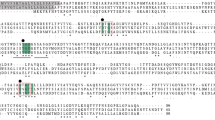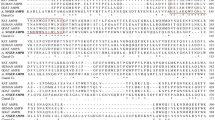Abstract
A novel endoprotease Endo-Pro-Aspergillus niger (endoprotease EPR) was first successfully expressed at high level in the methylotrophic yeast Pichia pastoris and the purification procedure was established. The endoprotease EPR is 95 % identity with proline specific endopeptidase from A. niger CBS513.88 (EMBL; AX458699), while sharing low identity with those from other microorganisms. The purified endoprotease EPR was a monomer of 60 kDa. Furthermore, the peptide mass fingerprinting (PMF) analysis confirmed that the purified protein was an endoprotease Endo-Pro-Aspergillus niger. A three-dimensional model revealed that the active site of the enzyme was located in Ser(179)-Asp(458)-His(491), based on template 3n2zB with sequence identity of 17.6 %. The optimum pH and temperature of the endoprotease EPR were pH 4–5 and 35 °C, and the stabilities were pH 3–7 and 15–60 °C, respectively. Furthermore, the endoprotease EPR had the ability to digest peptides with the C-terminal of proline as well as alanine, and was also capable of hydrolyzing larger peptides. The properties of the endoprotease EPR made it a highly promising candidate for future application in the field of brewing and food process.






Similar content being viewed by others
References
Araki H, Ouchi H, Uesugi S, Hashimoto Y, Shimoda T (1993) Prolyl endopeptidase and production thereof. EPO patent EP19920111124
Arentz-Hansen H, McAdam SN, Molberg Ø, Fleckenstein B, Lundin KE, Jørgensen TJ, Jung G, Roepstorff P, Sollid LM (2002) Celiac lesion T cells recognize epitopes that cluster in regions of gliadins rich in proline residues. Gastroenterology 123:803–809
Capiralla H, Hiroi T, Hirokawa T, Maeda S (2002) Purification and characterization of a hydrophobic amino acid specific endopeptidase from Halobacterium halobium S9 with potential. Process Biochem 38:571–579
Edens L, Dekker P, van der Hoeven R, Deen F, de Roos A, Floris R (2005) Extracellular prolyl endoprotease from Aspergillus niger and its use in the debittering of protein hydrolysates. J Agric Food Chem 53:7950–7957
Esparza Y, Huaiquil A, Neira L, Leyton A, Rubilar M, Salazar L, Shene C (2011) Optimization of process conditions for the production of a prolylendopeptidase by Aspergillus niger ATCC 11414 in solid-state fermentation. Food Sci Biotechnol 20:1323–1330
Gass J, Ehren J, Strohmeier G, Isaacs I, Khosla C (2005) Fermentation, purification, formulation, and pharmacological evaluation of a prolyl endopeptidase from Myxococcus xanthus: implications for celiac sprue therapy. Biotechnol Bioeng 92:674–684
Gass J, Khosla C (2007) Prolyl endopeptidases. Cell Mol Life Sci 64:345–355
Harwood VJ, Denson JD, Robinson-Bidle KA, Schreier HJ (1997) Overexpression and characterization of a prolyl endopeptidase from the hyperthermophilic archaeon Pyrococcus furiosus. J Bacteriol 179:3613–3618
Higgins DR, Cregg JM (1998) Methods in molecular biology: Pichia protocols. Totowa, NJ
Kabashima T, Fujii M, Meng Y, Ito K, Yoshimoto T (1998) Prolyl endopeptidase from Sphingomonas capsulata: isolation and characterization of the enzyme and nucleotide sequence of the gene. Arch Biochem Biophys 358:141–148
Kanatani A, Yoshimoto T, Kitazono A, Kokubo T, Tsuru D (1993) Prolyl endopeptidase from Aeromonas hydrophila: cloning, sequencing, and expression of the enzyme gene, and characterization of the expressed enzyme. J Biochem 113:790–796
Lopez M, Edens L (2005) Effective prevention of chill-haze in beer using an acid proline-specific endoprotease from Aspergillus niger. J Agric Food Chem 53:7944–7949
Mentlein R (1988) Proline residues in the maturation and degradation of peptide hormones and neuropeptides. FEBS Lett 234:251–256
Mitea C, Havenaar R, Drijfhout JW, Edens L, Dekking L, Koning F (2008) Efficient degradation of gluten by a prolyl endoprotease in a gastrointestinal model: implications for coeliac disease. Gut 57:25–32
Oyama H, Aoki H, Amano M, Mizuki E, Yoshimoto T, Tsuru D, Murao S (1997) Purification and characterization of a prolyl endopeptidase from Pseudomonas sp. KU-22. J Ferment Bioeng 84:538–542
Pel HJ, de Winde JH, Archer DB, Dyer PS, Hofmann G, Schaap PJ, Turner G, de Vries RP, Albang R, Albermann K et al (2007) Genome sequencing and analysis of the versatile cell factory Aspergillus niger CBS 513.88. Nat Biotechnol 25:221–231
Polgar L (2002) The prolyl oligopeptidase family. Cell Mol Life Sci 59:349–362
Polgar L (2002) Structure-function of prolyl oligopeptidase and its role in neurological disorders. Curr Med Chem 2:251–257
Riggle HM, Fisher MA (2009) Purification of a prolyl endopeptidase from Aspergillus oryzae and evaluation of its ability to digest gluten. http://oasys2.confex.com/acs/237nm/techprogram/P1239602.HTM
Schwede T, Kopp J, Guex N, Peitsch MC (2003) SWISS-MODEL: an automated protein homology-modeling server. Nucleic Acids Res 31:3381–3385
Shan L, Mathew II, Khosla C (2005) Structure and mechanistic analysis of two prolyl endopeptidase: role of interdomain dynamics in catalysis and specificity. PNAS 102:3599–3604
Shan L, Molberg Ø, Parrot I, Hausch F, Filiz F, Gray GM, Sollid LM, Khosla C (2002) Structural basis for gluten intolerance in celiac sprue. Science 297:2275–2279
Soisson SM, Patel SB, Abeywickrema PD, Byrne NJ, Diehl RE, Hall DL, Forf RE, Reid JC, Rickert KW, Shipman JM, Sharma S, Lumb KJ (2010) Structural definition and substrate specificity of the S28 protease family: the crystal structure of human prolylcarboxypeptidase. BMC Struct Biol 10:16
Sousa F, Ju S, Erbel A, Kokol V, Cavaco-Paulo A, Gubitz GM (2007) A novel metalloprotease from Bacillus cereus for protein fibre processing. Enzyme Microb Technol 40:772–781
Sridhar VR, Hughes JE, Welke DL, Broadbent JR, Steele JL (2005) Identification of endopeptidase genes from the genomic sequence of Lactobacillus helveticus CNRZ32 and the role of these genes in hydrolysis of model bitter peptides. Appl Environ Microbiol 71:3025–3032
Subba C, Sathish T, Ravichandra P, Prakasham RS (2009) Characterization of thermo- and detergent stable serine protease from isolated Bacillus circulans and evaluation of eco-friendly applications. Process Biochem 44:262–269
Stepniak D, Spaenij-Dekking L, Mitea C, Moester M, de RuA, Baak-Pablo R, van VP, Edens L, Koning F (2006) Highly efficient gluten degradation with a newly identified prolyl endoprotease: implications for celiac disease. Am J Physiol Gastrointest Liver Physiol 291:621–629
Szwajcer-Dey E, Rasmussen J, Meldal M, Breddam K (1992) Proline-specific endopeptidases from microbial sources: isolation of an enzyme from a Xanthomonas sp. J Bacteriol 174:2454–2459
Takii Y, Kurlyama N, Suzuki Y (1990) Alkaline serine protease produced-from citric acid by Bacillus alcalophilus subsp. halodurans KP 1239. Appl Microbial Biotechnol 34:57–62
Walter R, Simmons WH, Yoshimoto T (1980) Proline-specific endo- and exopeptidases. Mol Cell Biochem 30:111–127
Yoshimoto T, Walter R, Tsuru D (1980) Proline-specific endopeptidase from Flavobacterium: purification and properties. J Biol Chem 255:4786–4792
Xianchang X, Di Y, Fuping L, Yanlin G, Yu L (2009) Cloning of proline-specific endoprotease gene of Aspergillus niger and expression in Pichia pastoris. Ind Microbiol (in Chinese) 39:7–12
Acknowledgments
Financial support from the National High Technology Research and Development Program of China (863 Program) (No. 2012AA022207 and 2008AA10Z304), the Fundamental Research Funds for the Central Universities (JUSRP11014), and the Ministry of Education, R.P. China, and from NSFC (20802027) is greatly appreciated.
Author information
Authors and Affiliations
Corresponding authors
Rights and permissions
About this article
Cite this article
Kang, C., Yu, XW. & Xu, Y. Gene cloning and enzymatic characterization of an endoprotease Endo-Pro-Aspergillus niger . J Ind Microbiol Biotechnol 40, 855–864 (2013). https://doi.org/10.1007/s10295-013-1284-4
Received:
Accepted:
Published:
Issue Date:
DOI: https://doi.org/10.1007/s10295-013-1284-4




